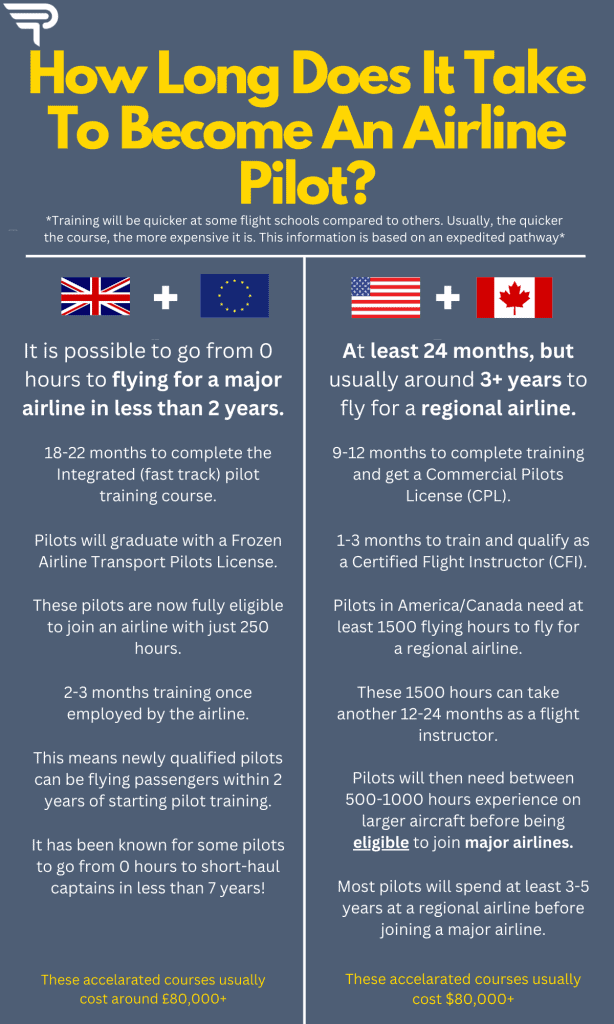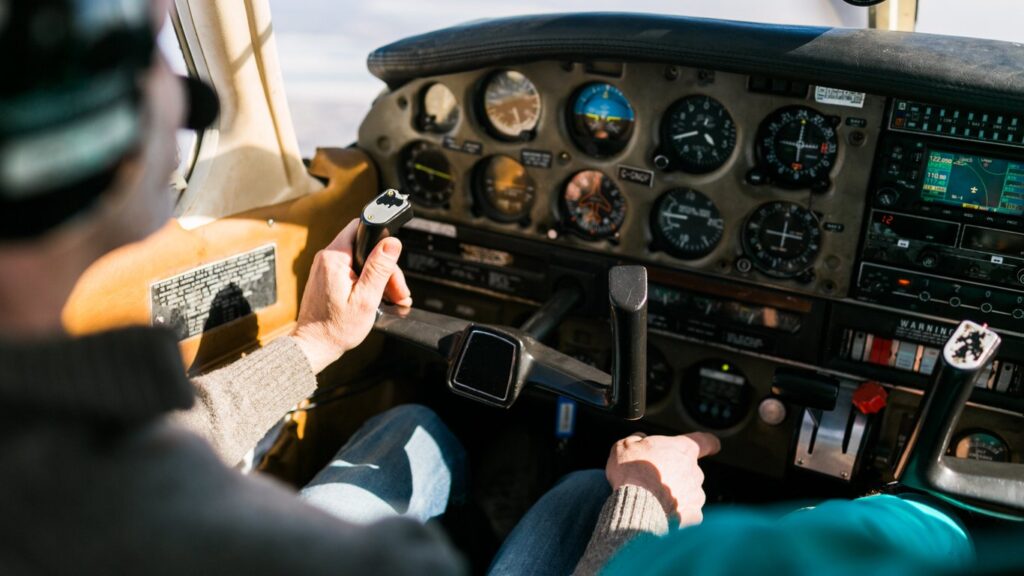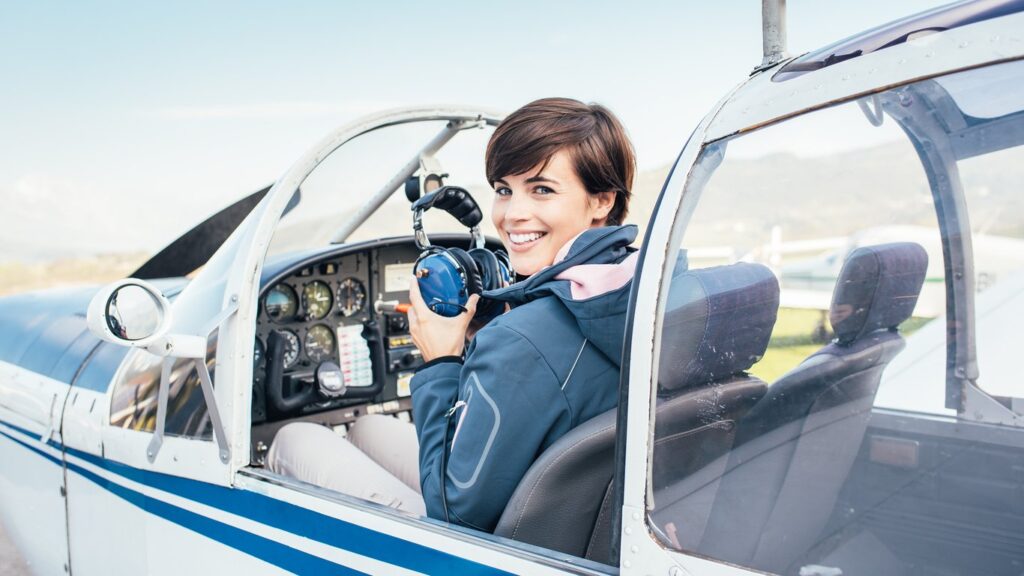Imagine realizing your childhood dream of soaring through the skies, being in command of a large aircraft, and traveling to new destinations. If you’ve ever wondered how long it takes to become a pilot, this article provides an insightful answer. From the initial training to gaining experience, we will explore the journey and the average number of years it takes to achieve this thrilling career. Get ready to embark on a captivating adventure into the world of aviation!

This image is property of 883b86fe.flyingcdn.com.
Types of Pilots
Commercial Pilot
A commercial pilot is someone who holds a professional pilot license and is qualified to fly aircraft for financial compensation or hire. These pilots are often employed by airlines to operate scheduled flights and transport passengers or cargo. Becoming a commercial pilot requires a higher level of certification and training compared to other types of pilots.
Private Pilot
A private pilot is someone who holds a private pilot license and is authorized to fly for recreational purposes or personal transportation. While private pilots cannot fly for compensation or hire, they can carry passengers and share the expenses of the flight. Obtaining a private pilot license is the first step for many aspiring aviators and is a popular choice for individuals who enjoy flying as a hobby.
Airline Transport Pilot
The airline transport pilot (ATP) is the highest level of pilot certification and is required for pilots who want to become captains or first officers in airlines. ATPs are responsible for operating large commercial aircraft, ensuring the safety of the passengers and crew, and adhering to strict aviation regulations. This certification demands extensive training, flight experience, and proficiency in various areas of aviation.
Pilot Training Requirements
To embark on a career as a pilot, there are certain training requirements that need to be fulfilled. These requirements ensure that aspiring pilots possess the necessary knowledge, skills, and capabilities to safely operate an aircraft.
Educational Qualifications
While there are no specific academic prerequisites to enroll in pilot training, a strong educational background is advantageous. Many airlines and flight schools prefer candidates with at least a high school diploma and some even require a bachelor’s degree in aviation or a related field. However, the most crucial aspect is a passion for aviation and a willingness to learn.
Age Requirements
The minimum age to start pilot training varies by country, but it is typically around 17 or 18 years old. However, to obtain certain certifications like the commercial pilot license and airline transport pilot license, the age requirement is usually higher, ranging from 21 to 23 years old. These age restrictions are in place to ensure that pilots have gained enough maturity and experience before operating complex aircraft.
Medical Certification
All pilots must undergo a thorough medical examination and obtain a medical certificate to ensure they are physically and mentally fit to fly. The medical assessment is conducted by authorized aviation medical examiners and considers factors such as vision, hearing, cardiovascular health, and psychological well-being. Maintaining a valid medical certificate is essential throughout a pilot’s career to maintain the privilege to fly.
English Language Proficiency
English is the international language of aviation, and pilots must demonstrate proficiency in English to effectively communicate with air traffic control and other aviation personnel. Aspiring pilots must undergo an English language assessment, usually conducted by a certified examiner, to assess their ability to speak, understand, read, and write in English. This requirement aims to ensure clear and efficient communication in the aviation environment.
Ground School Training
Ground school training forms the foundation of a pilot’s education and encompasses various theoretical aspects of aviation, including principles of flight, navigation techniques, aviation regulations, and aircraft operations. This classroom-based instruction is a crucial component of pilot training and provides aspiring aviators with the necessary knowledge and understanding to become skilled and competent pilots.
Theory and Basic Knowledge
Ground school typically begins with subjects related to the theory of flight, aerodynamics, and basic aviation principles. Aspiring pilots learn about aircraft components, the physics of flight, and the forces acting on an aircraft during different flight phases. Understanding these fundamental concepts is essential for safe and efficient flight operations.
Navigation and Meteorology
Navigation and meteorology are vital subjects covered in ground school training. Pilots learn how to interpret aviation charts, use navigational instruments, plan flight routes, and calculate fuel consumption. Meteorology classes focus on weather systems, studying weather reports and forecasts, and understanding the impact of weather conditions on flight safety and efficiency.
Aviation Regulations and Safety
Aviation regulations and safety protocols are an integral part of pilot training. Aspiring pilots become familiar with national and international aviation regulations, airspace management, air traffic control procedures, and emergency protocols. These lessons ensure that pilots operate within legal frameworks and adhere to standardized safety practices, reducing the risk of accidents and incidents.
Aircraft Systems and Operations
Ground school training also covers aircraft systems and operations, providing pilots with an in-depth understanding of the aircraft they will be operating. This includes studying the various subsystems and controls, emergency procedures, and abnormal operations. Familiarity with aircraft systems is crucial for identifying malfunctions and effectively responding to emergencies during flight.
Flight Training
After completing ground school, aspiring pilots progress to the practical aspect of their training, known as flight training. This hands-on instruction allows students to apply the knowledge gained in ground school and develop the necessary flying skills under the guidance of certified flight instructors.
Student Pilot License
Flight training usually begins with obtaining a student pilot license (SPL). This allows students to fly solo under certain conditions and gradually build their flight hours. During this phase, students focus on basic maneuvers, takeoffs, landings, and flight control techniques. They also learn how to navigate and communicate effectively with air traffic control.
Private Pilot License
The next step in flight training is achieving a private pilot license (PPL). This license allows pilots to fly for recreational purposes or personal transportation, but not for compensation or hire. PPL training further develops students’ flight skills, including advanced maneuvers, cross-country navigation, emergency procedures, and flying in different weather conditions.
Instrument Rating
An instrument rating (IR) is a significant milestone in a pilot’s training. This rating enables pilots to fly in conditions of reduced visibility using only the aircraft instruments. Instrument flying involves relying solely on instruments to control the aircraft’s attitude, altitude, and heading. During instrument training, pilots learn how to interpret instrument displays, fly precise instrument approaches, and handle emergency situations in limited visibility.
Commercial Pilot License
The commercial pilot license (CPL) is the gateway to a professional flying career. Pilots with a CPL can fly for hire or financial compensation. CPL training focuses on developing advanced flying skills, precision maneuvers, commercial flight operations, and an understanding of aviation regulations applicable to commercial pilots. Flight training for the CPL includes cross-country flights, night flights, and flying with passengers.
Multi-engine and Airline Transport Pilot License
For those aspiring to fly larger commercial aircraft or become airline pilots, additional flight training is required. Pilots must obtain a multi-engine rating, which allows them to operate aircraft with multiple engines. Subsequently, pilots undergo training and accumulate flight experience to qualify for an airline transport pilot (ATP) license. This license permits pilots to act as captains or first officers on commercial airliners.

This image is property of media.pea.com.
Required Flight Experience
In addition to the various licenses and ratings, pilots must accumulate a specified amount of flight experience to ensure competence and safety in their operations.
Minimum Flight Hours
The total flight hours required vary depending on the type and level of certification. Generally, to obtain a private pilot license, pilots must accumulate a minimum of 40-50 flight hours, which includes solo flight time and dual instruction. To qualify for a commercial pilot license, the requirement increases to approximately 250 hours of flight time, including cross-country flights.
Night Flight Experience
Experience in night flying is essential for both private and commercial pilots. Some training programs specify a minimum number of night flight hours, typically around 10-20 hours. These hours include navigation exercises, takeoffs, and landings during nighttime conditions to familiarize pilots with the challenges and considerations associated with nocturnal flying.
Cross-Country Flight Experience
Cross-country flight experience is crucial for pilots to develop navigational skills, execution of flight planning, and familiarization with different airports and airspace along their routes. For private pilots, a minimum cross-country flight of around 150-200 nautical miles is usually required. Commercial pilots need to accumulate several cross-country flights of extended distances to meet the requirements for their license.
Additional Ratings and Endorsements
Pilots can pursue additional ratings and endorsements to expand their skill set and increase their employability in the aviation industry.
Instrument Rating
Aside from the instrument rating required for commercial pilots, pilots can also obtain an instrument rating on specific types of aircraft, such as helicopters or multi-engine airplanes. This further enhances a pilot’s ability to fly in challenging weather conditions and provides opportunities for specialized aviation roles.
Multi-engine Rating
Obtaining a multi-engine rating is beneficial for pilots aiming to fly aircraft with more than one engine. This rating enables pilots to operate multi-engine aircraft with increased performance capabilities and prepares them for careers in commercial aviation or corporate flying.
Flight Instructor Rating
Becoming a flight instructor allows pilots to share their knowledge and skills with aspiring aviators. A flight instructor rating is obtained after meeting certain experience and training requirements. By becoming a flight instructor, pilots not only enhance their teaching abilities but also gain valuable flight hours and experience.
Airline Transport Pilot Rating
The airline transport pilot rating is the highest level of certification for pilots. It is obtained after fulfilling the required flight hours, usually a minimum of 1,500 hours. This rating allows pilots to act as pilots-in-command (captains) or first officers in commercial airlines and operate large, complex aircraft.

This image is property of d4y70tum9c2ak.cloudfront.net.
Type Rating and Aircraft Endorsements
To fly certain types of aircraft, pilots must obtain a type rating, which is specific to the make and model of the aircraft. Type ratings are necessary for operating large commercial jets or specialized aircraft with unique handling characteristics. Additionally, pilots may require aircraft endorsements for specific aircraft systems or equipment, such as high-performance aircraft or retractable landing gear.
Practical Examinations
To validate their knowledge and skills, pilots must undergo practical examinations administered by aviation authorities or designated examiners.
Written Knowledge Tests
Pilots are required to pass written knowledge tests to demonstrate their understanding of aviation theory, regulations, and procedures. These tests cover a wide range of subjects, including aerodynamics, meteorology, navigation, aircraft systems, and emergency procedures. Successful completion of written tests is necessary to proceed to the flight skills tests.
Flight Skills Tests
Flight skills tests, also known as practical flight exams or checkrides, evaluate a pilot’s ability to safely operate an aircraft and execute various flight maneuvers. These exams assess areas such as takeoffs and landings, emergency procedures, navigation, and precision flying. The examiner observes and evaluates the pilot’s performance, decision-making, and adherence to aviation regulations.

This image is property of ix-cdn.b2e5.com.
Flight Hours Accumulation
The time required to complete pilot training and accumulate the necessary flight hours varies based on the individual’s dedication, training program, and availability.
Time Needed for Each License
On average, it takes approximately 6-12 months to obtain a private pilot license, depending on the training intensity and frequency. Commercial pilot training can take an additional 12-18 months, considering the required flight time, theoretical exams, and skill development. The timeline for advanced ratings, such as the instrument rating and airline transport pilot license, may vary but typically requires several months of training.
Factors Affecting Training Duration
Several factors can influence the duration of pilot training. These include the availability of training aircraft and instructors, weather conditions, the student’s dedication and progress, and the specific requirements and regulations of the aviation authorities.
Training Expenses
Becoming a pilot requires a significant financial investment, as the costs of training, certifications, and flight hours can quickly add up. It is essential for aspiring pilots to consider the following aspects when budgeting for their training.
Cost of Ground School Training
Ground school training costs can vary depending on the training institution, country, and program chosen. Typically, ground school training costs range from a few thousand dollars to tens of thousands of dollars. These costs cover tuition fees, course materials, and access to aviation resources and simulators.
Flight Training Costs
Flight training expenses are a major component of pilot training. The costs mainly depend on the location, type of aircraft used, fuel prices, and the number of flight hours required for each certification. On average, obtaining a private pilot license can cost anywhere from $10,000 to $15,000, while commercial pilot training can range from $50,000 to $80,000. Advanced ratings and endorsements, such as the instrument rating and multi-engine rating, will add to the overall expenses.
Additional Expenses
In addition to the direct costs of training, aspiring pilots should consider additional expenses such as aviation medical examinations, flight equipment (headsets, flight bags, etc.), navigation tools, study materials, and any fees associated with written and practical exams. It is crucial to have a comprehensive understanding of the potential expenses and plan accordingly.
Becoming a pilot requires dedication, perseverance, and a genuine passion for aviation. While training can be demanding, the rewarding experience of flying an aircraft and being part of the aviation community makes the journey worthwhile. Through the various certifications, flight experience, and comprehensive training, pilots acquire the skills and knowledge necessary to ensure safe and efficient flight operations. So, if you dream of taking to the skies and embarking on a career in aviation, start your journey of becoming a pilot with a solid foundation and a commitment to lifelong learning.

This image is property of ix-cdn.b2e5.com.
